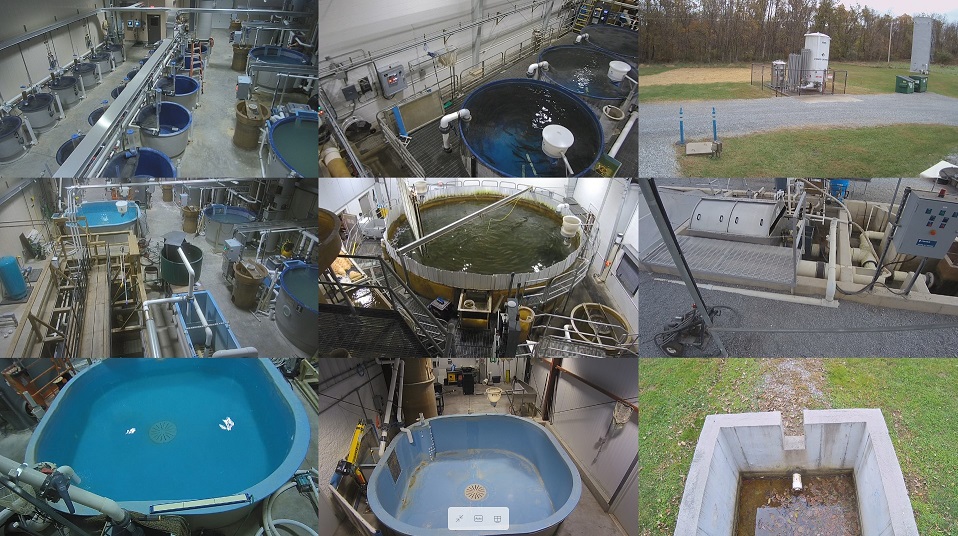
Features
Technology
Fresh Tips: A remote glimpse with the help of video monitoring
October 24, 2022 By From the experts at the Freshwater Institute
 Freshwater Institute webcams (Photo: Freshwater Institute)
Freshwater Institute webcams (Photo: Freshwater Institute) Video monitoring is an excellent tool with many uses for recirculating aquaculture system (RAS) managers. Video monitoring of culture tanks allows observation without the usual disturbance caused by approaching the fish. This allows operators to assess positioning, behavior, and feeding activity to gain insight into fish health and performance. At facilities where continuous water quality data is also recorded, stored video may provide clues to unexpected water quality parameter swings and allow corrective measures. Remote access to video monitoring is also useful when fielding off-hour alarm calls. Checking live video feeds may show water levels and flows are correct or confirm successful generator transfer. A remote glimpse into a RAS status can prime responding staff and reduce triage time upon arrival.
Scale
As you consider the benefits of installing a camera platform, you will naturally think about how many cameras you will need.
A smaller system in a single building may require fewer than five cameras, and operators unfamiliar with networking and computers may want to keep things simple. Items such as weather resistance, source of power, backup power, and connectivity are considerations at any scale, but consumer/prosumer camera systems will be easier to set-up. They should include an app for easy remote access and a feature to store your data in the cloud, but may have fewer camera options and provide limited access controls for managing multiple users.
Larger facilities needing more than five cameras will have a lot more flexibility including camera options, but may need someone with networking expertise to design the system. With a large camera system, you’ll need to design a sufficient onsite data storage and a fast (and possibly dedicated) onsite network to move the data. If you have many users, ensure that your system can assign permission levels to manage them – generally most users only need view-only access. Enterprise systems often use power over ethernet (POE) to combine data and power in a single network cable to ease installation.
Installing cameras
Mount cameras in a strategic location that protects them from splashing or being bumped by staff or equipment. Consider the vantage point of the mounting location and the angles the camera can be pointed. A well-positioned camera can provide a frame that includes views of swimming fish and key indicators of RAS operation like water levels, water channels, or fault indicator lights. Including a peripheral view of entry doors can also increase security around the facility.
Storage
If you have only a consumer/prosumer system, there will likely be a recurring fee to store and access the data. Pricing is generally based on the number of cameras and length of storage. There is often a standardized table of fee options, and the length of time for video storage before automatic deletion may be limited.
Onsite storage becomes desirable when there are many real-time cameras collecting image data. Your internal network connection to onsite devices is likely to be higher than your connection to the internet so with this approach, you maintain the capability to continuously save large amounts of data locally, while still having access to specific video streams remotely when you need them.
If your internal network cannot handle the demands of many concurrent video streams, consider a camera system where each camera stores the data internally. These types of systems can provide a dashboard which aggregates views from all the cameras while eliminating the continuous demands on your local network.
With larger enterprise systems, storage can be more difficult to compute because of the variables involved. You can optimize storage and bandwidth consumption by modifying camera resolution, framerate, image compression, and storage time. Additionally, some camera systems give the option to record only during certain times of day, when there is motion in a specific zone or when a specific object type is in the frame. Because onsite disk storage is relatively inexpensive, you may opt to buy more storage rather than spend the time optimizing your collected video.
Information access
Onsite access to video streams can often be accomplished via an installable program or web browser. When offsite, with an enterprise system you have the option of using a third-party virtual private network (VPN) to securely access onsite video from a remote desktop, but this adds complexity.
Consumer-based and modern enterprise systems have brand-specific apps for tablets and phones from one of the major app stores (e.g. Android, Apple). Actively supported apps will have multi-factor authentication and are likely to be highly rated in your app store. Ideally, both major app store platforms will be supported.
Choosing a system that automatically labels changes in the scene will improve your chances of discovering something of value in your recordings.
As a final note, employers should be aware of all legal obligations and ethical concerns around privacy when deciding to implement video monitoring at their facility.
Print this page